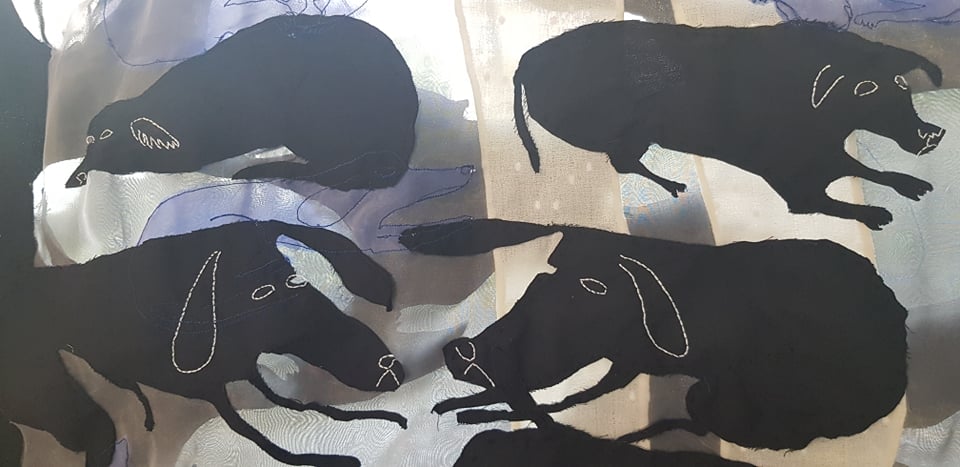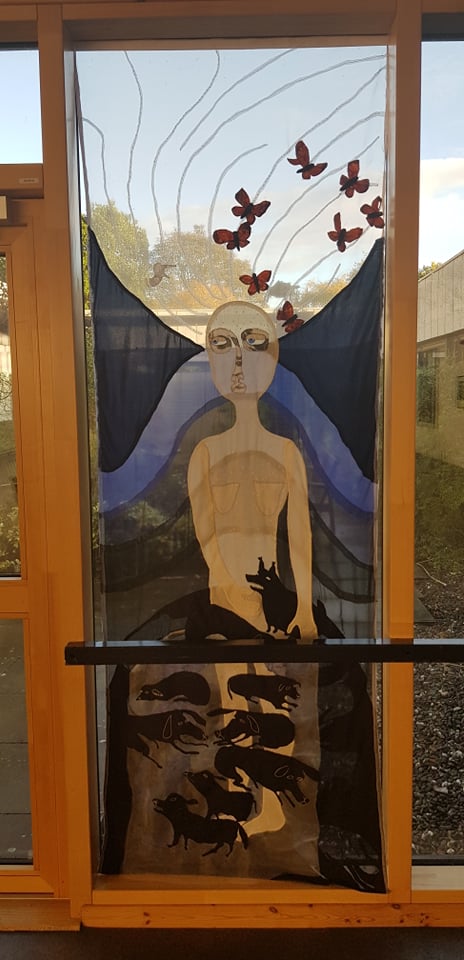The University of Stirling Art Collection is delighted to have on display a new work entitled ‘Encumbered’ by renowned textile artist Lindy Richardson as part of this year’s theme ‘The Art of Wellbeing’. The piece depicts Saint Dymphna, the patron saint of people suffering from depression, anxiety, and other forms of mental illness or unrest. Her story was first recorded in the 13th Century, though it is claimed to come from a long running story passed orally through generations.
Dymphna is said to have been the daughter of Damon, a 7th Century petty king of Oriel, which was an Irish over-kingdom that straddled the current border between Northern Ireland and the Republic of Ireland. She was converted to Christianity by her mother, who died when Dymphna was 14 years old. Distraught, King Damon told his courtiers that he would only remarry once he found someone as beautiful as his wife had been. However, as the years went by, he came to desire Dymphna as his next wife, due to the strong resemblance between her and her mother.
Learning of her father’s intentions, Dymphna fled the kingdom alongside her confessor Father Gerebernus, the kings fool, and two of her servants. They sailed towards mainland Europe, landing in the town of Geel in modern day Belgium. There she used the money she fled with to build a hospice to help the poor and the sick of the area.
Once her father learned where Dymphna was, he travelled to Geel with his men to try and force her to return home, however she refused to go with him. Enraged, Damon drew his sword and decapitated Dymphna, and the rest of her group were put to death for helping her. After Damon and his group left, the citizens of Geel gathered the bodies of Dymphna and Gerebernus and buried them nearby. Dymphna’s remains were later placed in a silver reliquary. They are currently held in St Dymphna church, which was built on the spot they were reburied in. Gerebernus, a saint in his own right, was later moved to the town of Sonsbeck in Germany, though his relics were destroyed by fighting during WW2.

The tapestry is reminiscent of the stained-glass windows that would bear the images of saints in churches and cathedrals, and uses light in the same way. At the bottom of the work are a pack of vicious black dogs that embody depression, which is commonly nicknamed “The Black Dog”. Saint Dymphna is resplendent in the centre of the image, keeping the hounds at bay. The spaces above and behind her are bright and clear, which also allows them to let the most light through. The butterflies are a counterpoint to the dogs below. Whilst dogs are direct and fast, butterflies float around seemingly aimlessly, rising above the problems of the world below and fluttering wherever they want.
Lindy Richardson has been practising her craft for decades, and has worked across commercial textiles, fine art and education. She refined her talents at both the Glasgow School of Art and the Royal College of Art. As well as her personal work, she has been the Director of Textiles at Edinburgh College of Art since 2000. You can find her on Instagram @embroiderednds
The tapestry of Saint Dymphna was custom made to be shown at the University and designed to perfectly fit within the frame of the window it resides in, in the Crush Hall gallery of the Pathfoot Building. It is on loan for the duration of the Art Collection’s themed exhibition focus for 2021-22, entitled ‘The Art of Wellbeing.’


